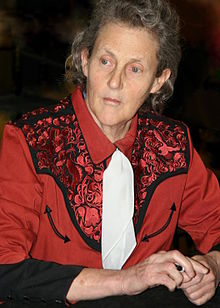Temple Grandin
| Temple Grandin | |
|---|---|

Grandin in 2011
|
|
| Born | Mary Temple Grandin August 29, 1947 Boston, Massachusetts, U.S. |
| Fields | |
| Institutions | Colorado State University |
| Alma mater | |
| Known for |
|
|
Website Grandin |
|
Mary Temple Grandin (born August 29, 1947) is an American professor of animal science at Colorado State University, world-renowned autism spokesperson and consultant to the industry on animal behavior. She is widely celebrated as one of the first individuals on the autism spectrum to publicly share insights from her personal experience of autism. She is also the inventor of the "hug box", a device to calm those on the autism spectrum. In the 2010 Time 100, an annual list of the 100 most influential people in the world, she was named in the "Heroes" category. She was the subject of the award-winning, semi-biographical film, Temple Grandin.
Temple Grandin was born in Boston, Massachusetts, into a highly educated and wealthy family. Her parents were Anna Eustacia Purves (an actress, singer and granddaughter of the co-inventor for the autopilot aviation system (John Coleman Purves), with a degree in English from Harvard University) and Richard Grandin, a real estate agent and heir to the largest corporate wheat farm business in America at the time, Grandin Farms. Grandin's parents subsequently divorced when she was 15 and her mother eventually went on to marry Ben Cutler, a renowned New York saxophonist, in 1965 (when Grandin was 18 years old). Grandin has three siblings - two sisters and a brother, with Grandin being the oldest. Grandin has described one of her sisters as being dyslexic. Her other sister is a sculptor and her brother a banker. John Livingston Grandin and his brother William James Grandin (Temple's paternal great grandfather), were French Huguenots who drilled for oil, intended to cut a deal with John D Rockefeller but the latter kept him waiting too long so he walked out before Rockefeller arrived. Then they went into banking and when Jay Cooke's firm collapsed they got thousands of acres of undeveloped land in North Dakota as collateral. They set up wheat farming in the Red River Valley there with dormitories for the workers and the town of Grandin is named after John Livingston Grandin.
...
Wikipedia
